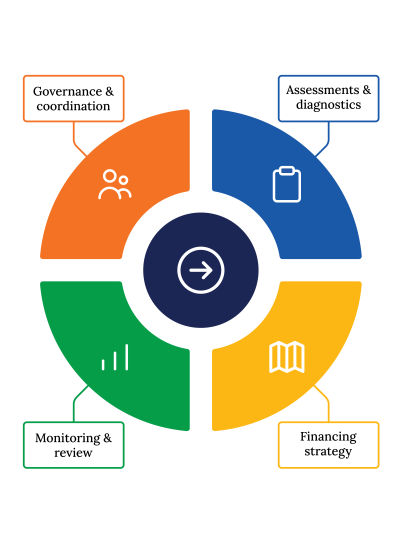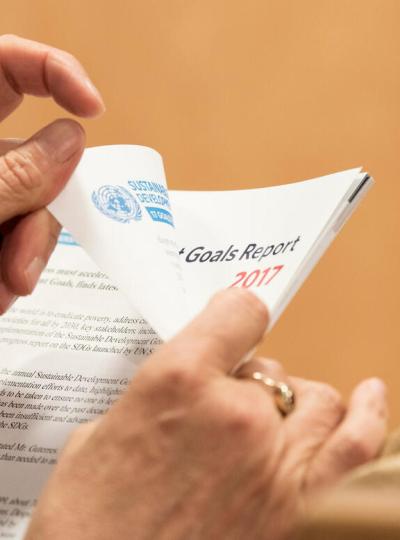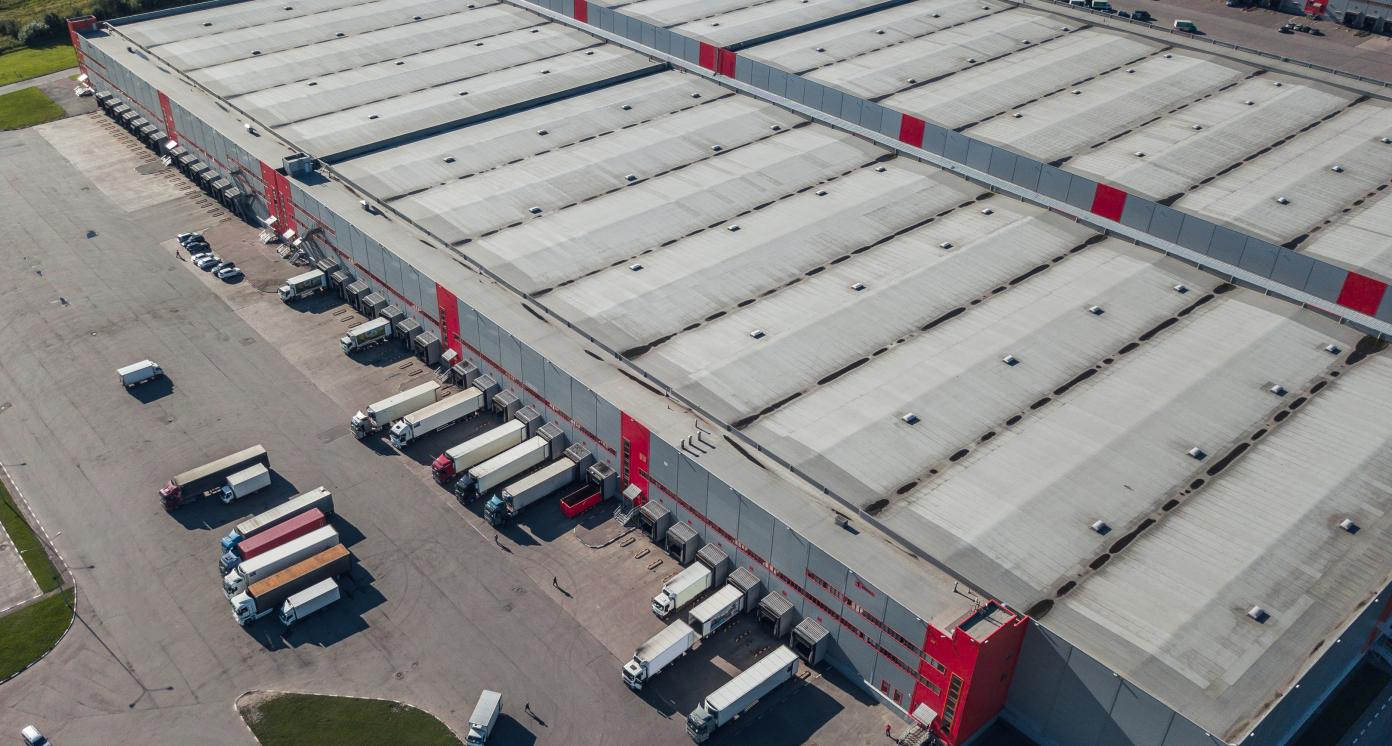Modern logistics centers for freight handling, cold storage, and digital supply chain integration
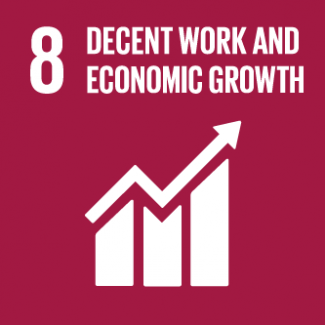
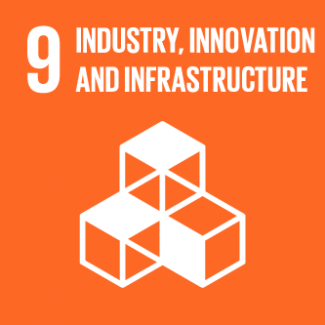
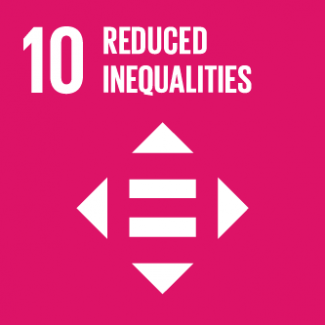
Business Model Description
Establish and operate logistics centers that provide warehousing, cold storage, cross-docking, and digital freight management, integrated with road and rail corridors. Services include customs support, last-mile delivery, and tailored solutions for exporters and e-commerce platforms.
Expected Impact
Modern logistics hubs will boost trade, cut emissions, and create inclusive jobs, driving regional growth and supply chain efficiency in the Republic of North Macedonia.
How is this information gathered?
Investment opportunities with potential to contribute to sustainable development are based on country-level SDG Investor Maps.
Disclaimer
UNDP, the Private Finance for the SDGs, and their affiliates (collectively “UNDP”) do not seek or solicit investment for programmes, projects, or opportunities described on this site (collectively “Programmes”) or any other Programmes, and nothing on this page should constitute a solicitation for investment. The actors listed on this site are not partners of UNDP, and their inclusion should not be construed as an endorsement or recommendation by UNDP for any relationship or investment.
The descriptions on this page are provided for informational purposes only. Only companies and enterprises that appear under the case study tab have been validated and vetted through UNDP programmes such as the Growth Stage Impact Ventures (GSIV), Business Call to Action (BCtA), or through other UN agencies. Even then, under no circumstances should their appearance on this website be construed as an endorsement for any relationship or investment. UNDP assumes no liability for investment losses directly or indirectly resulting from recommendations made, implied, or inferred by its research. Likewise, UNDP assumes no claim to investment gains directly or indirectly resulting from trading profits, investment management, or advisory fees obtained by following investment recommendations made, implied, or inferred by its research.
Investment involves risk, and all investments should be made with the supervision of a professional investment manager or advisor. The materials on the website are not an offer to sell or a solicitation of an offer to buy any investment, security, or commodity, nor shall any security be offered or sold to any person, in any jurisdiction in which such offer would be unlawful under the securities laws of such jurisdiction.
Country & Regions
- Republic of North Macedonia: Northeastern
- Republic of North Macedonia: Southwestern
Sector Classification
Transportation
Development need
North Macedonia’s transportation sector lacks modern infrastructure and multimodal integration, limiting its ability to support trade and economic growth. Despite its location along Corridors VIII and X, the country underperforms in regional transportation competitiveness. Investment in modern logistics hubs is urgently needed. (1)
Policy priority
Modernization of transportation networks as key priority, emphasizing multimodal transport, digital transition, and regional connectivity. EU-aligned strategies like IPA III also support investment in infrastructure and trade facilitation. (2, 3, 4)
Gender inequalities and marginalization issues
The transport sector has low female participation and limited access for marginalized groups. Barriers include lack of skills training and exclusion from decision-making roles. (5)
Investment opportunities introduction
Investment opportunities include digital logistics hubs, cold storage, and cross-docking facilities along EU corridors. Co-financing is available through IPA III, CEF, and PPPs. Green freight and waste logistics align with sustainability goals and support regional trade integration.
Key bottlenecks introduction
Challenges include outdated infrastructure, limited digitalization, customs inefficiencies, and fragmented regulations. Skills gaps, low innovation capacity, and underused PPPs hinder progress. Weak institutional coordination and limited access to funding constrain logistics development. (1, 3)
Land Transportation
Development need
North Macedonia’s land transport system is fragmented and outdated, limiting efficient cargo flow. There is an urgent need to modernize logistics corridors, optimize supply chains, and support digital and cold-chain integration to meet rising demands from regional trade and e-commerce. (1)
Policy priority
The National Development Strategy (NDS) prioritizes full integration with the TEN-T network through upgrades to Corridors VIII and X, modern freight hubs, and digital logistics solutions. These objectives align with EU and SEETO frameworks, positioning land transportation as a national enabler of trade, competitiveness, and sustainable mobility. (2)
Gender inequalities and marginalization issues
Few women and marginalized groups are represented in planning, training, and employment. The logistics sector offers an opportunity to address this through targeted skills development and inclusive recruitment. (2)
Investment opportunities introduction
Significant potential exists in logistics parks, dry ports, digital freight systems, and cross-border terminals. EU-aligned instruments like IPA III, CEF, and PPPs support investments in intermodal hubs and corridor infrastructure to boost trade efficiency, multimodal integration, and sustainable transport. (6)
Key bottlenecks introduction
Weak institutional coordination and inadequate multimodal infrastructure limit the sector’s capacity to enable efficient, integrated, and competitive trade and transport systems. (1, 2)
Road Transportation
Pipeline Opportunity
Modern logistics centers for freight handling, cold storage, and digital supply chain integration
Establish and operate logistics centers that provide warehousing, cold storage, cross-docking, and digital freight management, integrated with road and rail corridors. Services include customs support, last-mile delivery, and tailored solutions for exporters and e-commerce platforms.
Business Case
Market Size and Environment
USD 100 million - USD 1 billion
15–20 logistics centers required in strategic trade zones along Corridors VIII and X.
The Western Balkans logistics market is projected to exceed USD 5 billion by 2030, driven by regional integration, EU corridor investments, and trade facilitation efforts. North Macedonia’s share is estimated at USD 500 million–1 billion based on infrastructure gaps and geographic position. (11, 12)
Indicative Return
10% - 15%
10% - 15%
Logistics infrastructure projects in Southeast Europe have delivered internal rates of return (IRRs) between 10–14%, reflecting strong financial viability. These figures are driven by increasing trade volumes, regional connectivity improvements, and alignment with EU transport priorities. (13)
Similar logistics centers in Bulgaria and Serbia report non-leveraged returns on investment (ROI) ranging from 11–13%. These are supported by long-term contracts, corridor-based trade expansion, and EU-aligned investment frameworks that reduce project risk. (13)
Investment Timeframe
Long Term (10+ years)
Logistics infrastructure such as intermodal terminals, cold storage, and digital freight hubs requires multi-year planning, permitting, and phased construction, with full operational maturity and return generation typically achieved after 10+ years. (13)
Ticket Size
USD 500,000 - USD 1 million
Market Risks & Scale Obstacles
Market - Highly Regulated
Capital - CapEx Intensive
Business - Supply Chain Constraints
Impact Case
Sustainable Development Need
The transport sector in the Republic of North Macedonia contributes significantly to CO₂ emissions. Logistics centers optimized for multimodal transport and route efficiency can reduce emissions, fuel use, and urban congestion. (2)
The Republic of North Macedonia lacks modern cold chain and freight infrastructure, limiting access to markets for agri-food producers and exporters. Addressing this gap can enhance regional trade and reduce food loss. (22)
Gender & Marginalisation
Women are significantly underrepresented in the global transport sector workforce, comprising only 12% of transportation and storage workers worldwide. (23)
Rural and ethnic minority communities face higher unemployment and limited access to industrial zones and logistics careers. Investment in regional logistics hubs can offer equitable job opportunities. (24)
Youth from disadvantaged areas lack access to training in digital logistics, cold chain handling, and multimodal operations. This results in high NEET (Not in Education, Employment, or Training) rates, especially in rural areas.(25)
Expected Development Outcome
Enhanced logistics infrastructure will reduce CO₂ emissions through route optimization, multimodal transport use, and energy-efficient cold storage, contributing to greener freight mobility and urban decongestion.
Improved freight capacity, digital tracking, and cold chain services will reduce delivery times and spoilage, enabling SMEs and agri-food exporters to compete in EU markets and increase regional trade integration.
Gender & Marginalisation
Modernizing logistics networks will create targeted vocational programs for women in warehousing, digital freight, and cold chain logistics, increasing female participation and enabling career progression in a male-dominated sector.
Establishing logistics hubs in border and rural areas will expand employment access for underrepresented ethnic and geographic groups, helping close urban-rural gaps and boost inclusive economic development.
Through partnerships with training centers, marginalized youth can acquire logistics-specific skills (e.g. inventory tech, fleet coordination), enhancing employability and social mobility.
Primary SDGs addressed

8.2.1 Annual growth rate of real GDP per employed person
North Macedonia's real GDP per employed person grew at approx. 1.5–2.0% annually (2018–2022), below the EU average. Productivity remains low due to informality, low value-added sectors, and limited logistics efficiency. (26)
Raise labor productivity from $20.64 per hour (2021) to $30 by 2034 and $40 by 2044 through logistics modernization, skills development, and regional trade expansion. This supports North Macedonia’s alignment with EU convergence benchmarks and long-term economic competitiveness. (2)

9.b.1 Proportion of medium and high-tech industry value added in total value added
As of 2023, the Republic of North Macedonia’s Logistics Performance Index (LPI) is 3.1, indicating persistent challenges in freight efficiency, digital infrastructure, and cross-border connectivity. These limitations constrain industrial productivity and reduce the country’s competitiveness in regional and EU markets, especially in medium and high-tech sectors. (2, 27)
To address these gaps and boost economic performance, the Republic of North Macedonia aims to increase the contribution of medium and high-tech industries to 12–14% of total value added by 2030. This target will be supported by upgrading freight systems, enhancing digital logistics infrastructure, and improving industrial connectivity through the development of modern logistics hubs. (2)
Secondary SDGs addressed

Directly impacted stakeholders
People
Gender inequality and/or marginalization
Planet
Corporates
Public sector
Indirectly impacted stakeholders
People
Gender inequality and/or marginalization
Planet
Corporates
Public sector
Outcome Risks
New logistics hubs may lead to land conversion or urban sprawl, increasing pressure on peri-urban ecosystems and displacing agricultural land near corridors.
Large-scale logistics infrastructure could crowd out small logistics providers, leading to market concentration and reduced competitiveness in the sector.
Without investment in vocational programs, local workers may be excluded from digital logistics roles, limiting the intended employment outcomes and increasing reliance on external labor.
Impact Risks
If multimodal integration fails, logistics may default to road transport, undermining emissions reduction and sustainability targets.
Delays in customs reform or inter-agency coordination may limit cross-border logistics impact, slowing regional trade integration.
Without strong digital infrastructure or training, logistics firms may underuse smart systems, limiting efficiency and scale.
If not properly integrated with rail, increased freight demand may escalate road traffic, worsening air pollution and congestion in certain urban nodes.
Gender inequality and marginalization risk: If inclusion measures are not implemented, women and marginalized groups may be excluded from higher-value roles in logistics, limiting access to employment.
Impact Classification
What
Improved logistics infrastructure and services supporting trade efficiency, job creation, and green transport across key regional corridors.
Who
Women, youth, SMEs, and rural communities in North Macedonia and Balkan trade zones benefit from jobs and improved market access.
Risk
Integration failures, delays in customs reforms and improvement in digital infrastructure poses greatest risks to achieving impact.
Contribution
Improves trade connectivity, cuts transport emissions, and boosts competitiveness via logistics hubs, digital systems, multimodal links, and skilled workforce development.
How Much
North Macedonia's employment rate was 45.7% in the third quarter of 2023. The country aims to raise this to 52% by 2034 and reach 60% by 2044.[2]
Impact Thesis
Modern logistics hubs will boost trade, cut emissions, and create inclusive jobs, driving regional growth and supply chain efficiency in the Republic of North Macedonia.
Enabling Environment
Policy Environment
National Transport Strategy (NTS) 2018-2030. The NTS prioritizes modern logistics zones, intermodal hubs, and digital freight systems to enhance trade, reduce emissions, and align with EU TEN-T. It directly supports the goals for integrated, sustainable logistics infrastructure by 2030. (14)
The Reform Agenda 2024–2027 prioritizes connectivity, competitiveness, and green transition, supporting logistics infrastructure, regional integration, and investment—aligning with modern logistics centers for freight handling, cold storage, and digital supply chain integration. (15)
Waste Management Strategy 2020-2030. Promotes cleaner waste transport through optimized routing and fleet management, supporting green logistics goals. (28)
Industrial Strategy 2018-2027. Promotes productivity, industrial modernization, and innovation, particularly in processing sectors. It supports investment in logistics and green industry, aligning with smart specialization and EU integration priorities. [16]
Export Promotion Strategy 2024-2027. Promotes logistics capacity and export diversification by enhancing infrastructure, reducing trade barriers, and integrating domestic firms into regional and global value chains. Supports improved transport and customs services essential for logistics businesses. (17)
Financial Environment
Financial incentives: The Western Balkans Investment Framework (WBIF) supports logistics infrastructure via grants and blended financing. North Macedonia has received €486.5M for sustainable transport and digitalization projects. (18)
Fiscal incentives: Planned reforms will allow the use of intangible assets as collateral for SME lending, improving capital access for logistics and tech-driven ventures. This benefits operators lacking traditional fixed assets.(17)
Other incentives: Para-fiscal charge optimization lowers costs and regulatory hurdles for logistics enterprises. Streamlining 28 fees improves the business climate, making it easier to develop and scale modern logistics centers. (15)
Regulatory Environment
The Law on Road Transport regulates licensing, vehicle and operator requirements, and international agreements, directly shaping logistics operations and enabling safe, compliant freight mobility in North Macedonia. (19)
GS1 standards create a common foundation by uniquely identifying, capturing, and sharing data on products, locations, and assets. Using barcodes and electronic exchange, they improve transparency, tracking, and warehouse efficiency key for logistics centers and multimodal integration. (20)
Law on Electric Commerce offers underpins digital logistics by enabling secure EDI, electronic documentation and real‑time communication among operators, suppliers and customers, strengthening end‑to‑end delivery. (21)
Marketplace Participants
Private Sector
Major logistics operators, warehousing companies, and freight forwarders are driving intermodal service demand. Their investments in digital tracking and cold-chain facilities strengthen trade flows and regional connectivity.
Government
The Ministry of Transport leads logistics corridor development, while Customs Administration reforms border operations to align with EU standards, improving freight efficiency and compliance.
Multilaterals
The EU, World Bank, and EBRD support infrastructure and regulatory reforms. WBIF co-finances intermodal hubs and corridor projects that promote multimodal integration and digital transport systems.
Non-Profit
Business associations and logistics chambers advocate for reduced para-fiscal fees, investment incentives, and logistics workforce development, helping align national logistics strategies with SME needs.
Public-Private Partnership
Intermodal terminals, such as the one in Skopje, are developed through PPPs, blending public infrastructure planning with private sector efficiency and innovation in service delivery.
Target Locations
Republic of North Macedonia: Northeastern
Republic of North Macedonia: Southwestern
References
- (1) Strategy for Smart Specialization of Republic of North Macedonia 2024-2027 S3-MK
- (2) National Development Strategy 2024-2044
- (3) The Instrument for Pre-accession Assistance (IPA) III - Link: https://cfcd.finance.gov.mk/?page_id=6228&lang=en#:~:text=For%20the%20period%202021%2D2027,and%20to%20progressively%20align%20with
- (4) Economic Reform Programme 2022-2024, Ministry of Finance, Republic of North Macedonia. Link: https://finance.gov.mk/wp-content/uploads/2022/02/Economic-Reform-Programme-2022-2024.pdf
- (5) Analysis of the female participation on labor market, Ministry of labor and Social Policy and OSCE.
- (6) Answers from the conducted interwiews
- ("7) Kyriazopoulos, E. et al., (2006) : The Role of Freight Villages to the Development of the Balkan Region. The Case of Promachon Freight Village (Greek Bulgarian Borders), 46th Congress of the European Regional Science Association: ""Enlargement, Southern Europe and the Mediterranean"", August 30th - September 3rd, 2006, Volos, Greece, European Regional Science Association (ERSA), Louvain-la-Neuve" "8) Transport and Logistics in Bulgaria, Project “Promoting the advantages of investing in Bulgaria” BG 161PO003-4.1.01-0001-C0001, with benefi ciary InvestBulgaria Agency, has been implemented with the fi nancial support of the European Union through the European Fund for Regional Development and the national budget of the Republic of Bulgaria."
- (9) Western Balkans Competitiveness Outlook 2024: Serbia, OECD. Link: https://www.oecd.org/content/dam/oecd/en/publications/reports/2024/06/western-balkans-competitiveness-outlook-2024-serbia_1df89dd8/3699c0d5-en.pdf
- (10) From conducted interviews "11) South-East Europe Core Regional Transport Network, The European Union’s 2003 Regional CARDS Programme Albania, Bosnia & Herzegovina, Croatia, the former Yugoslav Republic of Macedonia, Montenegro, Serbia and UNMIK/Kosovo"
- (12) Retaining the Growth Momentum, Western Balkans Regular Economic Report, No.26, 2024
- (13) Transport Sector Strategy (2019–2024), European Bank for Reconstruction and Development (EBRD)
- (14) National Transport Strategy 2018-2030 of Republic of North Macedonia
- (15) Reform and Growth Facility for the Western Balkans - Reform Agenda of North Macedonia 2024-2027, Government of the Republic of North Macedonia
- (16) Industry Strategy of R. Macedonia 2018-2027, with Action Plan, Ministry of Economy
- (17) Strategy for export promotion 2024-2027, with Action Plan 2024-2025, Republic of North Macedonia
- (18) Western Balkans Investment Framework. Link: https://www.wbif.eu/beneficiaries/north-macedonia
- (19) Law on Road Transport ("Official Gazette of the Republic of Macedonia" No. 68/2004; 127/2006; 114/2009; 83/2010; 140/2010; 17/2011 and 53/2011).
- (20) GS1 Transport and Logistics Management Standards
- (21) Law on Electronic Commerce
- (22) Maksimovska S., A. et al. (2021) Disrupted Market Relations in Agriculture in North Macedonia: the COVID-19 Crisis. In Eastern European Countryside, 27.
- (23) World Bank (2025) Addressing Barriers to Women’s Participation in Transport
- (24) World Bank (2018) Achieving a brighter future for all FORMER YUGOSLAV REPUBLIC OF MACEDONIA SYSTEMATIC COUNTRY DIAGNOSTICS
- (25) ILO (2022) Young People Not in Education, Employment or Training (NEET) - Mapping and Policy Pointers
- (26) Strategy for formalizing the informal economy in the Republic of North Macedonia 2023 - 2027, Ministry of Finance "27) United Nations Industrial Development Organization (UNIDO), Competitive Industrial Performance (CIP) database. The proportion of medium and high-tech industry value added in total value added of manufacturing Source: United Nations Industrial Development Organization (UNIDO), Competitive Industrial Performance (CIP) d"
- (28) National waste management plan of Republic of North Macedonia 2021-2031 Ministry of environment and Physical planning (Skopje, 2021) "29) European Commission (2024) COMMISSION STAFF WORKING DOCUMENT, North Macedonia 2024 Report COMMUNICATION FROM THE COMMISSION TO THE EUROPEAN PARLIAMENT, THE COUNCIL, THE EUROPEAN ECONOMIC AND SOCIAL COMMITTEE AND THE COMMITTEE OF REGIONS"
- (30) IFC & UNEP. Cooler Finance: Mobilizing Investment for the Developing World’s Sustainable Cooling Needs (2024).
- (31) World Bank (2019). Project Information Document (PID), Agriculture Modernization Project
- (32) Program for the Development of the Northeastern Planning Region 2021-2026, Center for the Development of the Northeastern Planning Region
- (33) Program for the Development of the Southeastern Planning Region 2021-2026, Center for the Development of the Southeastern Planning Region
- (34) Program for the Development of the Southwestern Planning Region 2021-2026, Center for the Development of the Southwestern Planning Region












